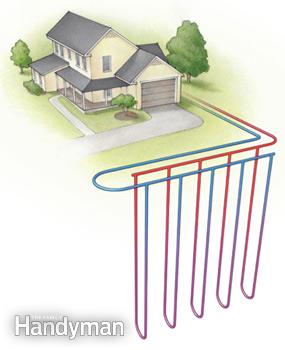The following is an excerpt taken from an interview with Dandelion (Geothermal) Co-Founder Kathy Hannun. For owners not familiar with Geothermal and how it works, please see below. Thanks to Rick Tonita for providing the information. For further info on our loop system including care and maintenance, please see our geothermal page on this site.
Could you quickly explain how geothermal energy works, and where it is particularly useful?
Geothermal heating and cooling is done by using a heat pump to move heat between the ground and a home or building. The term ‘heat pump’ may be unfamiliar, but heat pumps are actually ubiquitous in modern life: refrigerators are heat pumps, as are air conditioners. Both refrigerators and air conditioners use electricity to move heat from one place to another: in this case, from the inside (of the fridge or building) to the outside.
Geothermal heat pumps are similar, but instead of only moving heat in one direction, they are bidirectional. This allows them to both heat buildings and cool them. And instead of moving heat from the building to the outside air, like an air conditioner does, they move heat between the building and the ground.
This matters because heating your home is most urgent and essential when it’s very cold out, which is precisely when there is the least amount of heat in the outside air. And cooling your home is most urgent and essential when it’s very hot out, exactly when it would be most difficult to reject heat from your home into the outside air. This is why air conditioners are so difficult for the electricity grid: they operate least efficiently exactly when everyone uses them most, on the hottest days of the year.
Geothermal heat pumps sidestep this problem by exchanging heat with the ground instead of the outside air. The ground maintains a mild temperature year round (which is the average air temperature over the course of the year in that location). Because of this, even on the hottest or coldest days, geothermal is still extremely efficient and effective.
The heat that geothermal heat pumps collect from the relatively shallow surface is actually stored sunlight, not energy from the earth’s core, so despite the name ‘geothermal,’ geothermal heat pumps are actually using stored solar energy.
What are the benefits of geothermal heating and cooling?
Widespread geothermal heating and cooling will help address global warming. Will’s Creek is on the forefront on the use of geothermal heating and cooling. 1) Geothermal heat pumps have a critical role to play in offsetting carbon emissions from buildings. 2) It reduces heating and cooling costs which align the customer’s financial interests with society’s best interests. 3) Geothermal ground loops extend far into the ground and they last for as long as the home itself. After 20 years, when it’s time for the homeowner to replace their heat pump, they can just swap it out with another one and connect it with those same ground loops. 4) Geothermal heating and cooling add to the resale value of a home because of reduced operating costs and creating a superior home environment in comparison to other heating and cooling technologies.
Sent on behalf of Rick Tonita
Wills Creek|Creating community, Experience the difference
